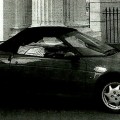-
 Diana Rigg
Diana RiggMrs. Peel’s Wheels: Diana Rigg takes a spin in the new Lotus Elan, a high-tech version of her Avengers sports car.
Vanity Fair
“With my tight leather suits on, I always had terrible difficulty getting out elegantly. You could just stand up, vaguely bend — no vaulting possible.” After a quarter of a century, Diana Rigg, once the auburn-haired, jumpsuited ice goddess Mrs. Peel, and the diminutive Lotus Elan were having a reunion. The reintroduced exotic two-seater is descended from the silver convertible the actress drove into male hearts on the Avengers series (now being rebroadcast on the A&E Network). In the interim, Rigg has acted in the Royal Shakespeare Company and in films, was honored by the Queen, and bore a daughter. The Elan sports car fared less well: it was dropped almost two decades ago from the Lotus lineup. Rigg currently hosts the weekly PBS Mystery! series, and she remains as alluring as the new Elan is low. “The nose is much squatter now; the hood used to be flatter, and it fell away less quickly,” she remarked before a test drive to a recording session at Wembley Studio.
As we stood across from Regent’s Park in London, Rigg confided that she has owned a custom-bodied 1930s Rolls-Royce convertible, a Mini, and one of the very first Range Rovers (“wonderful for the countryside, pretty daft for anything else”). She’s now on her third Mercedes-Benz 190E — but she has never owned a Lotus.

A reunion of woman and machine: Rigg remains glamorous and British to the core, while the Elan goes multinational.
Rigg squeezed a couple of fingers into a slot in an attempt to open the Elan’s composite resin door. “Good-bye, fingernails. Not for the lady,” she cried before sliding down, down into the driver’s seat. “Now let me try getting out. You swing your legs around — I’m pretty fit, but I’m quite long-legged.” (She’s five feet nine.) “I use the wheel as a support always, but this is a low car, so your push-off has to be from something higher.” She looked around the cabin. “Not having a proper shelf so that you can quickly reach a cassette, or money for the meter, is rather bad news. Not much storage space, either,” she added. “I smoke, and I don’t think you should have to circumnavigate the gearshift lever to get to the lighter.”
In a more classic British roadster, this sort of quibbling would be inappropriate. But the Elan is a new kind of multinational transport designed for comfort and fast, easy driving. Attempts to preserve Englishness in the sports-car experience — rows of chrome-bezeled Smith gauges mounted on a walnut dashboard, toggle switches hooked up to faulty Lucas wiring, pockets, fragrant Connolly leather, and unpredictable but thrilling high-speed handling — have been eschewed. Computer-aided design was used extensively in the Elan’s development, and C.A.D. knows no nationality.
Rigg stepped out and opened the trunk. “Yes, a regular-size suitcase would go in there, plus other things. In fact, I think 1 could just about get my weekly shop into the boot, but I’d have to shove the flowers behind the seats.” This is the first Lotus that comes close to being a daily driver. The turbocharged four-cylinder engine was designed by Isuzu, and some other crucial bits and pieces come from General Motors, which bought Lotus in 1986. It has an aura of reliability.
“What’s the body made of now?” Rigg inquired, thinking back to her Emma Peel days. “I had a couple of accidents when I was asked to do fast turns and things, and I was rather horrified by the amount of fiber that was revealed. One doesn’t expect a car to be fibrous.” A couple of days before, I had observed the “vacuum-assisted resin injection” molding process at the Lotus works outside Norwich. Armed with massive shears, pattern cutters shape sheets of woven polyester-resin fiberglass into flattened doors, hoods, and trunk lids. These are layered, stitched together, and positioned inside a mold. Liquid resin is forced through openings into the chamber. After a twenty-minute bake, the three-dimensional panels are ready to be plucked out, smooth and free of imperfections, and far more resistant to nicks and dings than steel.
Rigg adjusted the mirrors and sorted out the switches in preparation for the journey to Wembley via the London Orbital System. As she ignited the LotusIsuzu engine, I asked if there was anything familiar about the sound. “Certainly. The switching on before the direct call to action,” she replied. “Although the engine, you say, is now made in Japan, presumably there are similarities with the old one, because it does sound the same.” In fact, there’s no such thing as a purely Lotus-Isuzu engine. The company’s mainstay, a huge research-and-design department that dwarfs the car division, is hired by nearly every manufacturer from Porsche to Isuzu, knowing full well its blueprints may be adapted to other companies’ products. Perhaps that’s why the Elan lacks a certain character and urgency, as if Lotus had created it around the latest technology as a calling card for its R&D division.
Dodging the London buses and taxis, Rigg took a practical view. “Nowadays the industry has to be an amalgam of different countries’ technology, surely. Is anything purely English these days, I wonder? I’m delving back into the mists oftime now, but the old car was definitely more fragile, and it was also more fundamental, in a way. We didn’t even use seat belts in those days. ” (The new Elan features a driver’s-side air bag, impact-resistant bumpers, and a windshield frame strengthened to help withstand a roIlover. Anti-lock brakes aren’t included.)
“They’ve got good contouring on the seats,” she smiled. “The back support is terrific. Finally someone has subscribed to the medical delineation of what is required for a seat.” She found the instrument panel less accommodating. “White numbers on black dials would be easier to read than these red-on-black ones.” In addition, glare often makes the gauges illegible. “Is the cassette player included?” (It is.) “It always makes me cross when you have to pay extra. But it’s worse when it’s standard and they give you something really cheap and nasty.” The fine Sony stereo system has CD capability, and can be pulled out easily, so the car can be left unattended with the top down.
Despite its small size, the Elan is a surprisingly good long-distance cruiser, notwithstanding the raised console on the transmission tunnel directly aft of the gearshift lever. “I hate, absolutely loathe, banging my elbow against it,” Rigg cried, shifting into third. “You have to learn to leave your elbow by your side. One accommodates the car, but I think largely the car should accommodate the human body.”
London taxis looming on either side of us reinforced the Elan’s Lilliputian aspect, but Rigg didn’t feel vulnerable. “You don’t feel you’re in such a small car, perhaps because they’ve placed the windshield at an angle and further away than usual. They’ve given you a sense of space.” The expansive windshield helps fill with light a very wide and rather grim matte black cabin that looks as if it had been lifted from a sedan and foreshortened. Red leather accents on the seats and doors are standard in the hide interiors of the U. K. cars, but must be special-ordered in the U.S., albeit at no extra cost. In a bizarre cultural reversal, the distributor thought Americans would find them vulgar.
“Three lanes go down to two here, and you’ve got to be pretty nippy,” Rigg pointed out. “This car is … Mr. Ford Escort has been left behind. You can be over the limit in no time flat without knowing it,” she cautioned. The turbocharged engine directs power to the front wheels with jetlike propulsion and almost no lag. Unfortunately, for an average-size man, the steering-wheel rim obscures the top half of the speedometer in the U.S. cars, which have a nonadjustable wheel.
“‘The Hanger Lane Gyratory Orbital System.’ Sounds like it should be exciting, but I bet it isn’t,” Rigg said, stopping at the BBC studios for directions. I asked if she wanted to lower the top, a simple three-step procedure that leaves nothing but smooth, aerodynamic surfaces, so that passengers aren’t pelted by wind, even at high speeds. “I think cars are for privacy, which is why I’d never drive along with the top down,” she declined firmly. “I’m in my own car, in my own place, and I don’t want to advertise myself. I think people in sports cars want to advertise. It goes with having your wireless blasting. Bad taste, basically.
“The feel of the steering is very good,” she said, rejoining the freeway, “though the car’s a bit noisy for distances. I think our senses are assaulted so often that care should be taken, particularly when you’re in an enclosed space, to keep noise to a minimum.” The Group Lotus Noise, Vibration & Harshness Laboratory agrees, and is developing an “anti-noise” mechanism that produces sound waves that cancel noise waves.
Fewer than a thousand Elans will come to the U.S., at roughly $40,000 each; the $34,000 target price was unobtainable due to a weak dollar. Ronald Foster, Lotus’s U.S. CEO maintains, “We knew we didn’t want a replica of a sixties car.” Instead they’ve provided a jazzy convertible with much of the smoothness and interior atmosphere of a sedan, albeit one with stunning acceleration. The Lotus handles so predictably even lesser drivers will feel like Jackie Stewart, an attribute shared with the popular $15,000 Mazda Miata — an unabashed, less substantial copy of the old rear-wheel-drive Elan.
If the reunion of the classically trained, quintessentially English Diana Rigg with an Elan gone aeronautical led to a slight clash of empires, it’s a confirmation that Lotus Cars has turned global. It’s also a bittersweet reminder that MG and Triumph are no more, and that Jaguar is now a division of Ford. MG
published March 1991

